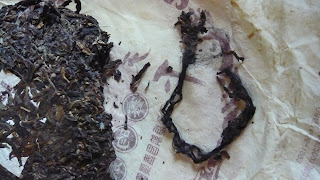This tea is from Bret at Tea Goober blog (many thanks!).
In my impression, most of Chang Tai's tea of those a couple of years named after "mountains" are quite enjoyable. At that time, Chang Tai was the leader of "mountain tops" teas, and was probably the only private company that could share the same table with Dayi and Xiaguan. Gold Bamboo Mountain is one of the relative stable series of Chang Tai and was offered in most of the years since... around 2002?? (I remember the starting year of Gold Bamboo Mountain is a big puzzle and hot spot of Chang Tai gossips...) It's in medium price range and a style I like very much. Just last year or early this year, I learned that Gold Bamboo Mountain (金竹山) is actually the same as Bitter Bamboo Mountain (苦竹山). Bitter Bamboo Mountain is a series that I like very much from another tea producer. And I didn't know these two "bamboo mountains" were actually the same mountain! It looks like that Bitter Bamboo Mountain was the original name, and Chang Tai (or somebody else around the time) renamed it to Gold Bamboo Mountain. You have to admit, in a commercial market, the latter one sounds more upscale and romantic. And indeed Chang Tai is good at this kind of things ;-)
Gold Bamboo Mountain is in Jing Gu (景谷) region, one of the home bases of Chang Tai. Although Chang Tai established their fame mostly with Yi Wu tea, some of their Jing Gu teas are very good, such as these twins.
Lovely dry stored leaves!
Sometimes when I get a chunk of tea, I would be reluctant to further break it. Then I would ended up using too much tea and regretted... I've been working on "not to use too much tea."
This is really too much tea... But this tea is very nice. It tastes like some arbor tree tea that doesn't get too harsh even when highly concentrated. But still, I think using too much tea is not a good situation and very often too wasteful. I brewed many infusions out of this tea. But later on, when I could taste the "straw-like" flavor from the top layer tea leaves that's typically found in a puerh near the end of brewing, I knew the leaves in the middle layer hadn't completely release all their flavors yet. I would rather brew these leaves in two different sessions instead of confining so much tea in such a small space. That's the number 2 reason I object brewing too much tea in each session - the number 1 reason is too concentrated tea polyphenols and too much caffeine all at one time is not very healthy, at least not healthy for my little subtle stomach :-p
This is the type of tea broth that I like very much!
In recent years I tasted quite a few samples of Gold Bamboo Mountain around 2003-2005, most of which are Guangdong dry-stored. Bret's Texas stored is one of the tastiest (and I guess Bret got his tea from a US source, likely from a dry enough place), along with a few other dryer stored samples. Many Guangdong dry stored teas I've tried are clean enough, but the humidity takes tolls on the aroma of the tea. And I think the unique aroma is the signature strength of Gold Bamboo Mountain. In contrast, some other teas I've had seemed to benefit some level of humidity (all of these are still within dry storage scope), such as the 2004 Xin Yun Cheng, and the Guangdong version in the 2003 Yi Wu twins (I will finish the report on the twins soon).
六堡茶道美学煮茶
3 years ago





































